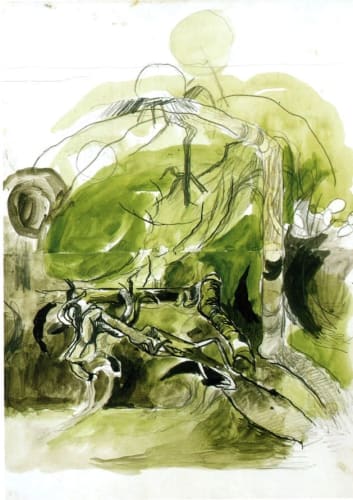Graham Sutherland, born in 1903 in Streatham, London, was one of the foremost artists of his generation, known for his portraiture, glasswork, printmaking, and work with fabrics. He begun his career as an engineering apprentice at the Midland Railway works in Derby, but left in 1921 to attend Goldsmiths’ School of Art, where he specialised in etching and engraving. In 1925 and 1928, Sutherland showed with the XXI Gallery, and in the 1920s made his reputation as a printmaker. These early works were influenced by Samuel Palmer. From 1926, when he graduated from Goldsmiths’, Sutherland taught engraving at the Chelsea School of Art.
In the 1930s, Sutherland turned to design and painting, the latter mainly landscapes that approach biomorphism. This Surrealist tendency in his work led to his being included in the 1936 International Surrealist Exhibition in London. In 1934, Sutherland made the first of many trips to Pembrokeshire, an obsession with the area that ended with the Second World War. Between 1935 and 1940, Sutherland also taught composition and book illustration at Chelsea. He had his first solo show in London in September 1938, at the Rosenberg and Helft Gallery, and in New York in 1946.
During the Second World War, Sutherland was employed by the War Artist’s Advisory Committee, and recorded bomb damage in Wales, and London. In 1944 he went to various sites in England and France to depict their scenes of devastation. In 1954, Sutherland was commissioned to design the tapestry for the rebuilt Coventry Cathedral, which took three years to complete.
After the end of the War, Sutherland begun painting in the French Riviera, and, starting in 1949, painted a number of portraits. Perhaps the most infamous of these was his painting of Churchill (1954), which was subsequently destroyed on the orders of Lady Churchill. Nonetheless, he was given many prestigious commissions, and in 1960 was awarded the Order of Merit (one of many awards). In 1951 he produced work for the Festival of Britain, and a year later exhibited at the Venice Biennale. From 1948 to 1951, Sutherland was a trustee of the Tate Gallery. In 1951 he had a major retrospective at the ICA, followed by others at the Tate (1982), the Musée Picasso, Antibes (1998), and the Dulwich Picture Gallery (2005)
Towards the end of his life, Sutherland returned to Pembrokeshire, and visited and worked there regularly until his death in 1980.

